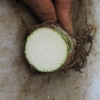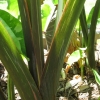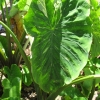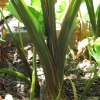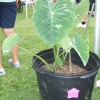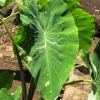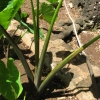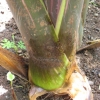Use As Food
Makes good poi of a light gray color.
Distribution
Very common throughout Hawai‘i. Taro of this family are common grown in māla (dryland) and lo‘i (wetland). It is very hardy with a comparative resistance to root rot. Popular as an ornamental because of its color splotchy lū‘au (leaves).
General Characteristics
Short to medium in height, moderately spreading, stocky, maturing within 7 to 12 months, producing from 5 to 10 ‘ohā; readily identified by green- and white-patchy color (mottled) lū‘au (leaves).
Ha (Petiole)
50 to 75 cm. long. The Hā starts, green, but becomes darker red after 3 – 4 months, with white stripes. Yellowish at top (apex), pink at lihi (stem edge). A brownish-lilac at the kōhina (base).
Lau or Lu'au(Leaf Blade)
35 to 50 cm. long, 25 to 35 cm, wide, 30 to 40 cm. from tip to base of sinus (māwae), egg-shaped (ovate), fairly firm in texture, slightly concave (curve inward), green- and white- patchy color (mottled); margins wave-like (undulate); piko small, yellowish.
'I'o kalo (Corm)
Flesh white with yellowish fibers; skin cream-colored.
Pua (Flower)
Remarks
This variety displays true variegation (color mix). The striking green and white mottling of the leaves makes the plant very attractive. The amount of white area varies to a certain extent, according to environmental conditions. 91. ‘Elepaio Hā Uliuli and 23. ‘Elepaio are similar in appearance with their spotted leaves. The differences are, 1. The lū ‘au (leaf) of ‘Elepaio Hā Uliuli is more ovate (round) than the leaf of ‘Elepaio, which is more narrow (sagittate). 2. The Hā of ‘Elepaio Hā Uliuli is a darker red color at maturity. ‘Elepaio is green. 3. The corm color of ‘Elepaio Hā Uliuli is white with yellowish fibers. The corm color of ‘Elepaio is light pink with pink fibers.

